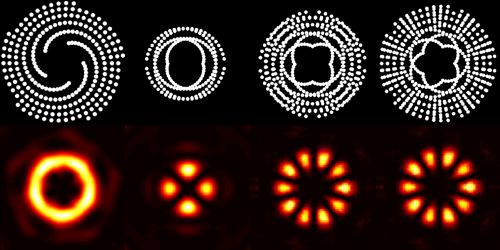Twisting Light Beams on Demand
The development of optics was built on controlling light’s many properties, such as wavelength and polarization. Today, scientists are extending that control to a property called orbital angular momentum, or OAM. A light beam structured with OAM has a helical wave front that causes a particle in the beam to orbit the beam’s axis of propagation. Different OAM modes exist—distinguished by the number of intertwined helices they contain. Yuanjie Yang from the University of Electronic Science and Technology of China and colleagues devised a simple, new way to produce both single OAM modes and multimode combinations by passing a plane wave of light through a plate with a calculated pattern of pinholes. Endowing beams with a custom spectrum of OAM modes could be useful for various structured-light applications, including data transmission, precision measurement, and manipulating nanoparticles.
OAM modes are difficult to produce, typically requiring complex optical elements like spiral phase plates or amplifiers with asymmetric cavities. The pinhole method from Yang et al. is comparatively simple. The team showed that spiral pinhole patterns produced single OAM modes, whereas more intricate petal patterns delivered pairs of oppositely spiraling modes. Surprisingly, the researchers also demonstrated how using just two pinholes could generate an OAM comb, which—like an optical frequency comb—is a spectrum of equally spaced modes. Specifically, a pinhole pair produced a series of OAM modes with only even or only odd numbers of helices, depending on the input light. The OAM comb’s spectrum could eventually be used as a kind of ruler for measuring the OAM modes contained in an arbitrary light beam.
This research is published in Physical Review Applied.
–Ryan F. Mandelbaum
Ryan F. Mandelbaum is a science writer at Gizmodo.





